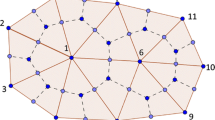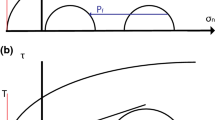Summary.
In a fractured rock mass, variations in stress and fluid pressure induced by engineering activities can significantly affect the hydrogeological properties. A significant change in fracture transmissivities can also be experienced in the far-field. The simulation of this kind of change requires a Hydro-Mechanical (HM) coupled model. The purpose of this paper is to show how such a model can be used to analyse the evolution of deformation and pressure in a fracture subjected to fluid injection. A 2D BEM-FEM code is used to solve the non-linear system of equations that describe the dependency of transmissivity on local fracture closure. The results of a sensitivity analysis of the essential fracture parameters allow one to gain insight into the importance of the HM models in the framework of the hydrogeology of fractured rock masses. Results obtained from a system of two impervious blocks and a saturated fracture are reported, in order to show the possibilities offered by this technique.
Similar content being viewed by others
References
Alm, P. (1999): Hydromechanical behaviour of a pressurized single fracture: an in situ experiment. PhD Thesis, Chalmers University of Technology, Göteborg, Sweden.
S. Bandis A. Lumsden N. Barton (1983) ArticleTitleFundamentals of rock joint deformation Int. J. Rock Mech. Min. Sci. Geomech. Abstr. 20 IssueID6 249–268 Occurrence Handle10.1016/0148-9062(83)90595-8
J. Bear (1979) Hydraulics of groundwater McGraw-Hill New York
J. Bear Y. Bachmat (1990) Introduction to modeling of transport phenomena in porous media Kluwer Academic Publisher Dordrecht
A. Becker (1992) Boundary element method in engineering McGraw-Hill Maidenhead
C. Brebbia J. Telles L. Wrobel (1984) Boundary element techniques Springer-Verlag Berlin Heidelberg New York Tokyo
F. Cornet L. Li J. Hulin I. Ippolito P. Kurowski (2003) ArticleTitleThe hydromechanical behaviour of a fracture: an in situ experimental case study Int. J. Rock Mech. Min. Sci. 40 1257–1270 Occurrence Handle10.1016/S1365-1609(03)00120-5
Fidelibus, C. (2003): A code for the hydro-mechanical response of an assembly of rock blocks and discrete fractures. Tech. Rep. ETH Report 3465/29, ETH, Zürich, Switzerland.
C. Fidelibus G. Barla M. Cravero (1997) ArticleTitleA mixed solution for two-dimensional unsteady flow in fractured porous media Int. J. Numer. Anal. Methods Geomech. 21 619–633 Occurrence Handle10.1002/(SICI)1096-9853(199709)21:9<619::AID-NAG893>3.0.CO;2-V
R. Goodman (1976) Methods of geological engineering in discontinuous rock West Publishing New York
Hakami, E. (1995): Aperture distribution of rock fractures. PhD Thesis, Royal Institute of Technology, Stockholm, Sweden.
P. Huyakorn G. Pinder (1983) Computational methods in subsurface flow Academic Press New York
McDermott, C. I., Kolditz, O. (2004): Hydraulic-geomechanical effective stress model: determination of discrete fracture network parameters from a pump test and application to geothermal reservoir modelling. In: Proc. 29th Workshop on Geothermal Reservoir Engineering, Stanford, California, pp SGP-TR-175.
S. Saeb B. Amadei (1992) ArticleTitleModelling rock joints under shear and normal loading Int. J. Rock Mech. Min. Sci. Geomech. Abstr. 29 IssueID3 267–278 Occurrence Handle10.1016/0148-9062(92)93660-C
M. Souley F. Homand B. Amadei (1995) ArticleTitleAn extension to the Saeb and Amadei constitutive model for rock joints to include cyclic loading paths Int. J. Rock Mech. Min. Sci. Geomech. Abstr. 32 IssueID2 101–109 Occurrence Handle10.1016/0148-9062(94)00039-6
H. Wang (2000) Theory of linear poroelasticity Princeton University Press Princeton
I. Yeo M. D. De Freitas R. Zimmerman (1998) ArticleTitleEffect of shear displacement on the aperture and permeability of a rock fracture Int. J. Rock Mech. Min. Sci. 35 IssueID8 1051–1070 Occurrence Handle10.1016/S0148-9062(98)00165-X
R. Zimmerman G. Bodvarsson (1996) ArticleTitleHydraulic conductivity of rock fractures Transp. Porous Media 23 1–30 Occurrence Handle10.1007/BF00145263
Author information
Authors and Affiliations
Rights and permissions
About this article
Cite this article
Cammarata, G., Fidelibus, C., Cravero, M. et al. The Hydro-Mechanically Coupled Response of Rock Fractures. Rock Mech. Rock Engng. 40, 41–61 (2007). https://doi.org/10.1007/s00603-006-0081-z
Received:
Accepted:
Published:
Issue Date:
DOI: https://doi.org/10.1007/s00603-006-0081-z




